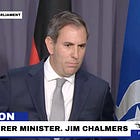Government Expands Low-Income Retirement Support, Boosting Offset by 62% to Benefit 3.1 Million Australians
This piece is freely available to read. Become a paid subscriber today and help keep Mencari News financially afloat so that we can continue to pay our writers for their insight and expertise.
Today’s Article is brought to you by Empower your podcasting vision with a suite of creative solutions at your fingertips.
The Australian government announced Monday it will substantially increase financial support for low-income workers’ retirement savings, raising the Low Income Superannuation Tax Offset from $500 to $810 and expanding eligibility from workers earning up to $37,000 annually to those earning up to $45,000, changes projected to benefit 1.3 million additional Australians with 60 percent being women.
Treasurer Jim Chalmers, the Member for Rankin in Queensland, unveiled the enhancement to the Low Income Superannuation Tax Offset—commonly abbreviated as LISTO—as part of a broader package of superannuation reforms approved by Cabinet Monday morning. The changes represent one of six major modifications to previously announced retirement savings taxation policy.
“The first one is to increase the low income superannuation tax offset, the listo, to increase it from $500 to $810 and also to raise the eligibility from $37,000 cut off to $45,000,” Chalmers told reporters at a press conference, according to a transcript of his remarks.
The expansion will bring the total number of Australians eligible for the LISTO to 3.1 million when fully implemented in 2027, timing the change to coincide with the government’s third stage of personal income tax cuts.
Truth matters. Quality journalism costs.
Your subscription to Mencari directly funds the investigative reporting our democracy needs. For less than a coffee per week, you enable our journalists to uncover stories that powerful interests would rather keep hidden. There is no corporate influence involved. No compromises. Just honest journalism when we need it most.
Not ready to be paid subscribe, but appreciate the newsletter ? Grab us a beer or snag the exclusive ad spot at the top of next week's newsletter.
Retirement Impact Projections
Government calculations suggest the enhanced offset will translate to approximately $15,000 in additional retirement savings for affected workers, according to Chalmers’ characterization of “one realistic calculation.”
The LISTO functions as a compensatory mechanism designed to address a structural inequity in Australia’s superannuation system, wherein low-income earners can face higher tax rates on contributions within their retirement funds than they pay on their regular income.
“The low income super tax offset, the listo, has always been about topping up super for people on low incomes recognising that they’re paying tax in the fund and sometimes that’s more than what they are paying outside the fund because they are on relatively low incomes,” Chalmers explained.
Gender Equity Focus
The Treasurer emphasized the policy’s disproportionate benefit to women, with female workers representing 60 percent of the 1.3 million Australians who will newly qualify under the expanded eligibility threshold.
Chalmers specifically acknowledged Minister for Finance and Minister for Women Katy Gallagher, a Northern Territory Senator, for her role in shaping the government’s approach to the LISTO enhancement.
“Here I shout out the Minister for Women, Katie Gallaher, for the role that she’s played in finalising our approach to the listo,” Chalmers stated.
The focus on women reflects longstanding concerns about the gender superannuation gap, with women typically retiring with significantly lower balances than men due to factors including interrupted workforce participation for caring responsibilities and lower average earnings.
Timing and Tax Cut Alignment
Unlike other components of Monday’s superannuation announcement, which will take effect July 1, 2026, the LISTO changes are scheduled for implementation in 2027. Chalmers directly connected this timing to the government’s staged personal income tax reduction plan.
When asked by reporters whether the LISTO expansion was necessitated by the tax cuts potentially creating situations where workers between $37,000 and $45,000 in annual income would pay higher concessional tax rates than income tax rates, Chalmers confirmed this was “part of the motivation, but it’s not the whole motivation.”
“One of the reasons why it’s aligned with our third set of tax cuts is that reason,” the Treasurer said. “But even absent that, we’re always looking for ways to get a better outcome for people on low incomes in superannuation.”
Adequacy Concerns Addressed
Chalmers framed the LISTO enhancement within broader government efforts to address what he characterized as an “adequacy issue” in Australia’s superannuation system, particularly affecting low-income workers and women.
“If you think about our superannuation system, it is genuinely the envy of the world, but there’s an adequacy issue for people on low incomes,” Chalmers said. “There’s an adequacy issue particularly for women.”
The adequacy challenge stems from Australia’s compulsory employer contribution system, currently set at 12 percent of wages, which means lower-income workers accumulate smaller retirement balances despite consistent contribution rates. This mathematical reality is compounded for workers with interrupted employment patterns or part-time work arrangements.
Revenue Context
The enhanced LISTO will reduce government revenue by approximately $435 million, according to figures Chalmers provided when discussing the broader revenue impacts of Monday’s superannuation package. This cost represents the foregone tax revenue from the increased payments to eligible low-income workers.
The Treasurer positioned this expenditure as an investment in retirement adequacy, arguing it aligns with the government’s objective of ensuring Australians are “earning more, keeping more of what they earn, and also retiring with more.”
Comparison to High-Balance Changes
Chalmers drew a stark numerical contrast between the LISTO beneficiaries and Australians who will face increased taxes on high superannuation balances under other reforms announced Monday.
“14 times more people will benefit from the low income super changes than will be impacted by the better targeted tax concessions,” Chalmers stated, referring to the approximately 90,000 Australians who will face the new 30 percent tax rate on earnings from balances exceeding $3 million.
The Treasurer characterized this ratio as evidence of the reform package’s progressive nature, arguing it demonstrates the government’s commitment to fairness “from top to bottom” in the superannuation system.
Broader Low-Income Support Measures
When questioned by reporters about poverty statistics showing nearly 4 million Australians living below the poverty line, Chalmers positioned the LISTO enhancement alongside other government initiatives aimed at supporting lower-income Australians, including increases to JobSeeker payments, rent assistance, energy bill relief, and social housing investments.
“We’re a Labor government and from budget to budget we do what we can to help people on low and fixed incomes,” Chalmers said. “We’re doing it today with the changes to low income super tax offset.”
The Treasurer acknowledged advocacy from organizations including the Australian Council of Social Service (ACOSS) calling for more substantial increases to income support payments, while defending the government’s incremental approach.
“I respect the contribution, important contribution that ACOSS makes to the public policy debate,” Chalmers said. “This government has increased the base rate of JobSeeker in a permanent and ongoing way in addition to the indexation, which means that JobSeeker is more than $100 more than when we came to office.”
Consultation and Implementation
Unlike the more complex components of Monday’s superannuation announcement, which require additional consultation with the superannuation industry regarding calculation methodologies, the LISTO enhancement appears technically straightforward as an expansion of an existing program.
The offset currently operates as a direct payment from the Australian Taxation Office to eligible individuals’ superannuation accounts, effectively refunding up to $500 of tax paid on concessional superannuation contributions for workers earning up to $37,000 annually.
The expanded program will function identically but with higher payment amounts and broader eligibility, requiring primarily administrative and systems adjustments rather than fundamental structural changes.
Historical Context
The LISTO was introduced in 2017, replacing an earlier program called the Low Income Superannuation Contribution that provided similar support. The offset addresses a specific inequity whereby low-income workers pay the standard 15 percent tax rate on employer superannuation contributions even when their marginal personal income tax rate is zero due to the tax-free threshold.
Australia’s superannuation system, established in its current form by the Keating Labor government in the early 1990s, requires employers to contribute a percentage of wages—currently 12 percent—to employees’ retirement savings accounts. These contributions are taxed at a flat 15 percent rate regardless of the employee’s income level, creating the inequity that LISTO addresses.
Political Reception Uncertain
The government will need to secure passage of the LISTO enhancement through the Senate, where it lacks a majority. Chalmers confirmed he had discussed the broader superannuation package with Greens Senator Larissa Waters Monday morning but declined to predict whether the minor party would support the legislation.
The LISTO component appears likely to attract broader political support than the high-balance taxation measures, given its progressive nature and direct benefit to lower-income workers, though passage timelines remain unclear.
Implementation in 2027 provides the government with an extended timeframe to secure legislative approval compared to the July 1, 2026 commencement date for other package components.
Sustaining Mencari Requires Your Support
Independent journalism costs money. Help us continue delivering in-depth investigations and unfiltered commentary on the world's real stories. Your financial contribution enables thorough investigative work and thoughtful analysis, all supported by a dedicated community committed to accuracy and transparency.
Subscribe today to unlock our full archive of investigative reporting and fearless analysis. Subscribing to independent media outlets represents more than just information consumption—it embodies a commitment to factual reporting.
As well as knowing you’re keeping Mencari (Australia) alive, you’ll also get:
Get breaking news AS IT HAPPENS - Gain instant access to our real-time coverage and analysis when major stories break, keeping you ahead of the curve
Unlock our COMPLETE content library - Enjoy unlimited access to every newsletter, podcast episode, and exclusive archive—all seamlessly available in your favorite podcast apps.
Join the conversation that matters - Be part of our vibrant community with full commenting privileges on all content, directly supporting The Evening Post (Australia)
Catch up on some of Mencari’s recent stories:
It only takes a minute to help us investigate fearlessly and expose lies and wrongdoing to hold power accountable. Thanks!








